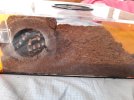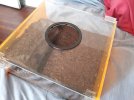thehotdogman93
New Member
- Messages
- 8
- Location
- CA, USA
So I just picked up my first T, a female Brachypelma Hamorrii about half a week ago, and she's awesome! I went to a local pet store a couple of days ago and picked up a Eco Earth compact brick, and a hide for her. After adding water, the coco fiber grew, and I left it outside so it could dry out. The next day, I took her out, I shoveled the old dirt around and pulled out some of the webbing she had layed in the old dirt. Her enclosure now has a mixture of new semi moist coco fiber and old fiber it seems.
Ever since then, she's been crawling around the sides of her enclosure like she wants to escape. I don't know if she's looking for something like food or water, or if it's the new fiber that making her uncomfortable. This wasn't happening before I redid her enclosure.
I'll update with some pictures here soon. I even caught her stuck on the ceiling once.
Ever since then, she's been crawling around the sides of her enclosure like she wants to escape. I don't know if she's looking for something like food or water, or if it's the new fiber that making her uncomfortable. This wasn't happening before I redid her enclosure.
I'll update with some pictures here soon. I even caught her stuck on the ceiling once.



